Articles
- Page Path
- HOME > J Musculoskelet Trauma > Volume 20(2); 2007 > Article
-
Original Article
- Treatment with Modified Steinmann Pins and Tension Band Wiring Technique in Proximal Humeral Comminuted Fractures with Osteoporosis
- Soo-Tai Chung, M.D., Joo-Hak Kim, M.D., Hyung-Soo Kim, M.D., Sang-Joon Park, M.D.
-
Journal of the Korean Fracture Society 2007;20(2):184-189.
DOI: https://doi.org/10.12671/jkfs.2007.20.2.184
Published online: June 14, 2016
Department of Orthopaedic Surgery, Myongji Hospital, Kwandong University College of Medicine, Goyang, Korea.
- Address reprint requests to: Joo-Hak Kim, M.D. Department of Orthopaedic Surgery, Myongji Hospital, Kwandong University College of Medicine, 697-24, Hwajeong-dong, Deogyang-gu, Goyang 412-270, Korea. Tel: 82-31-810-5409, Fax: 82-31-810-6537, hand0123@kwandong.ac.kr
Copyright © The Korean Fracture Society. All rights reserved
- 354 Views
- 1 Download
Abstract
-
Purpose
- To evaluate the usefulness of internal fixation with modified Steinmann pins and tension band wiring technique in comminuted proximal humeral fracture with osteoporosis and the correlations among bone mineral density, age, Neer's score and period of union.
-
Materials and Methods
- Twelve cases of comminuted proximal humeral fracture with osteoporosis were surgically treated with modified Steinmann pins and tension band technique, and followed up for an average 20.8 months (range, 6~39 months). Average age was 73.6 years old (range, 59~85 years old). Results were assessed using Neer's evaluation criteria.
-
Results
- Excellent results were noted in eight cases and satisfactory results in four cases. Radiological union was obtained in all cases. Two cases showed impingement syndrome of the proximal portions of Steinmann pins, which were managed by early removal of the metal. One case developed operative wound infection, which were managed by antibiotics therapy, irrigation and secondary closure.
-
Conclusion
- Internal fixation using modified Steinmann pins and tension band wiring technique for proximal humeral fracture, with osteoporosis, makes complete union of fracture, minimizes risk of complications, and enables early rehabilitation by rendering relatively rigid fixation.
- 1. Bengner U, Johnell O, Redlund-Johnell I. Changes in the incidence of fracture of the upper end of the humerus during a 30-year period. A study of 2,125 fractures. Clin Orthop Relat Res, 1988;231:179-182.
- 2. Bigliani LU. Fractures of the proximal humerus. In: Rockwood CA, Masten FA, editors. The shoulder. 1st ed. Philadelphia: WB Saunders Co; 1990. p. 287-334.
- 3. Bigliani LU, Fratow EL, Pollck RG. Fractures of the proximal humerus. In: Rockwood CA, Masten FA, editors. The shoulder. 2nd ed. Philadelphia: WB Saunders Co; 1998. p. 280-337.
- 4. Chun JM, Chung ER, Kim KY. Measurement of proximal humerus in Korean adult skeleton. J Korean Orthop Assoc, 1999;34:219-226.ArticlePDF
- 5. Cummings SR, Cauley LA, Palermo L, et al. Racial difference in hip axis lengths might explain recial difference in rates of hip fracture. Study of Osteoporotic Fractures Research Group. Osteoporos Int, 1994;4:226-229.
- 6. Cundy T, Cornish J, Evans MC, Gamble G, Stapleton J, Reid IR. Sources of interracial variation in bone mineral density. J Bone Miner Res, 1995;10:368-373.
- 7. Cuomo F, Flatow EL, Maday MG. Open reduction and internal fixation of two and three-part dispalaced surgical neck fractures of the proximal humerus. J Shoulder Elbow Surg, 1992;1:287-295.
- 8. Dennison E, Mohamed MA, Cooper C. Epidemiology of osteoporosis. Rheum Dis Clin North Am, 2006;32:617-629.Article
- 9. DePalma AF, Cautilli RA. Fractures of the upper end of the humerus. Clin Orthop, 1961;20:73-93.
- 10. Flatow EL, Cuomo F, Maday MG, Miller SR, McIlveen SJ, Bigliani LU. Open reduction and internal fixation of two-part displaced fractures of the greater tuberosity of the proximal part of the humerus. J Bone Joint Surg Am, 1991;73:1213-1218.Article
- 11. Hagg O, Lundberg BJ. Aspects of prognostic factors in comminuted and dislocated proximal humerus fractures. In: Bateman JE, Welsh RP, editors. Surgery of the shouder. Philadelphia: BC Decker; 1984.
- 12. Hall RF Jr, Pankovich AM. Ender nailing of acute fracture of the humerus. J Bone Joint Surg Am, 1987;69:558-567.
- 13. Hawkins RJ, Angelo RL. Displaced proximal humeral fractures. Selecting treatment, avoiding pitfalls. Orthop Clin North Am, 1987;18:421-431.Article
- 14. Hawkins RJ, Bell RH, Gurr K. The three-part fracture of the proximal part of the humerus. J Bone Joint Surg Am, 1986;68:1410-1414.
- 15. Hawkins RJ, Kiefer GN. Internal fixation techniques for proximal humeral fractures. Clin Orthop Relat Res, 1987;223:77-85.
- 16. Horak J, Nilsson BE. Epidemiology of fracture of the upper end of the humerus. Clin Orthop Relat Res, 1975;12:250-253.Article
- 17. Kang JD, Kim HC, Kyoung CW, Seo HC. Case-control study of risk factors of fracture due to osteoporosis. J Korean Soc Fract, 2002;15:7-14.Article
- 18. Ko JY, Yamamoto R. Surgical treatment of complex fracture of the proximal humerus. Clin Orthop Relat Res, 1996;327:225-237.Article
- 19. Koval KJ, Blair B, Takei R, Kummer FJ, Zuckerman JD. Surgical neck fractures of the proximal humerus: a laboratory evaluation of ten fixation techniques. J Trauma, 1996;40:778-783.
- 20. Kristiansen B. External fixation of proximal humeral fracture. Clinical and cadaver study of pinning technique. Acta Orthop Scand, 1987;58:645-648.
- 21. Kristiansen B, Christensen SW. Plate fixation of proximal humeral fractures. Acta Orthop Scand, 1986;57:320-323.Article
- 22. Kristiansen B, Kofoed H. External fixation of displaced fracture of the proximal humerus. Technique and preliminary results. J Bone Joint Surg Br, 1987;69:643-646.
- 23. Kristiansen B, Kofoed H. Transcutaneous reduction and external fixation of displaced fractures of the proximal humerus. A controlled clinical trial. J Bone Joint Surg Br, 1988;70:821-824.
- 24. Lee KW, Hwang IS, Lee SH, et al. Treatment of two-part, displaced surgical neck fracture of the proximal humerus with modified Ender nail and tension band technique. J Korean Soc Fract, 1999;12:395-401.Article
- 25. Leyshon RL. Closed treatment of fractures of the proximal humerus. Acta Orthop Scand, 1984;55:48-51.Article
- 26. Neer CS 2nd. Displaced proximal humeral fractures. II. Treatment of three-part and four-part displacement. J Bone Joint Surg Am, 1970;52:1090-1103.
- 27. Neer CS 2nd. Displaced proximal humeral fractures. I. Classification and evaluation. J Bone Joint Surg Am, 1970;52:1077-1189.
- 28. Ogiwara N, Aoki M, Okamura K, Fukushima S. Ender nailing for unstable surgical neck fractures of the humerus in elderly patients. Clin Orthop Relat Res, 1996;330:173-180.Article
- 29. Paavolainen P, Bjorkenheim JM, Slatis P, Paukku P. Operative treatment of severe proximal humeral fractures. Acta Orthop Scand, 1983;54:374-379.Article
- 30. Savoie FH, Geissler WB, Vander Griend RA. Open reduction and internal fixation of three-part fractures of the proximal humerus. Orthopedics, 1989;12:65-70.Article
- 31. Sehr JR, Szabo RM. Semitubular blade plate for fixation of the proximal humerus. J Orthop Trauma, 1988;2:327-332.
- 32. Stableforth PG. Four-part fractures of the neck of the humerus. J Bone Joint Surg Br, 1984;66:104-108.ArticlePDF
- 33. Sturzenegger M, Fornaro E, Jakob RP. Results of surgical treatment of multifragmented freactures of the humeral head. Arch Orthop Trauma Surg, 1982;100:249-259.
- 34. Sung JH, Kim WY, Han CW, Ryu JD, Son HS, Kim JY. Operative treatment using minimized internal fixation and tension band technique on proximal humeral fracture. J Korean Orthop Assoc, 1998;33:1852-1858.ArticlePDF
REFERENCES
Fig. 1
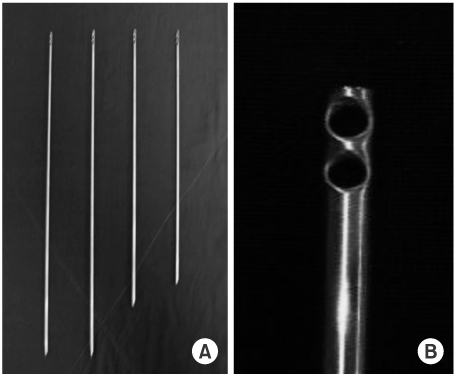
(A) Modified steinmann pins have different sizes. (B) Modified steinmann pin has proximal two holes.

Fig. 2
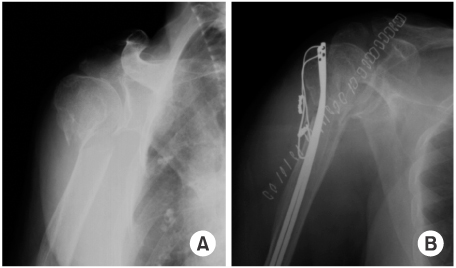
(A) Initial radiograph shows a surgical neck fracture of the proximal humerus, eighty five-year-old woman. (B) Postoperative radiograph shows intramedullary fixation with two modified Steinmann pins and one tension band wiring.

Fig. 3

(A) Initial radiograph shows a 3 part fracture of the proximal humerus sixty eight-year-old woman. (B) Postoperative radiograph shows intramedullary fixation with two modified Steinmann pins and two tension band wirings.

Figure & Data
REFERENCES
Citations
Citations to this article as recorded by 

Treatment with Modified Steinmann Pins and Tension Band Wiring Technique in Proximal Humeral Comminuted Fractures with Osteoporosis


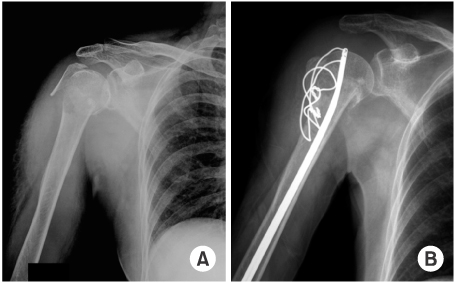
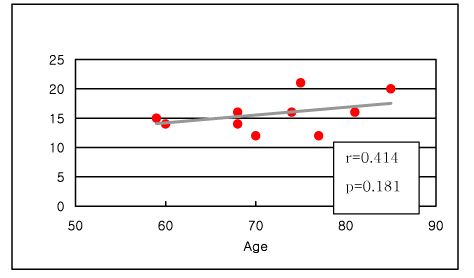
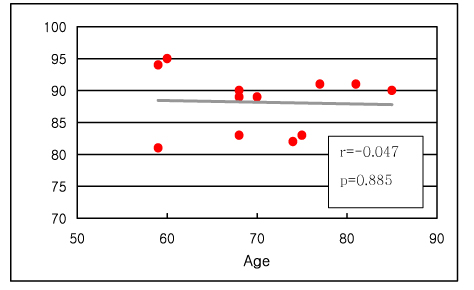
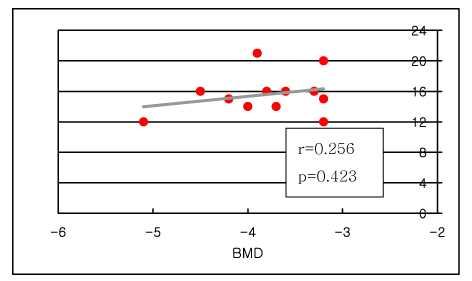
Fig. 1
(A) Modified steinmann pins have different sizes. (B) Modified steinmann pin has proximal two holes.
Fig. 2
(A) Initial radiograph shows a surgical neck fracture of the proximal humerus, eighty five-year-old woman. (B) Postoperative radiograph shows intramedullary fixation with two modified Steinmann pins and one tension band wiring.
Fig. 3
(A) Initial radiograph shows a 3 part fracture of the proximal humerus sixty eight-year-old woman. (B) Postoperative radiograph shows intramedullary fixation with two modified Steinmann pins and two tension band wirings.
Fig. 4
This graph shows a correlation between age and average of Neer's score.
Fig. 5
This graph shows a correlation between age and average of union period.
Fig. 6
This graph shows a correlation between BMD and average of union period.
Fig. 1
Fig. 2
Fig. 3
Fig. 4
Fig. 5
Fig. 6
Treatment with Modified Steinmann Pins and Tension Band Wiring Technique in Proximal Humeral Comminuted Fractures with Osteoporosis
Patient data
*Neer's classification. T. A: Traffic accident, Fx: Fracture, F/U: Follow up, Mon: Months, Wks: Weeks.
Results according to Neer's evaluation criteria
S: Satisfactory, E: Excellent. *3 part fracture.
Table 1
Patient data
*Neer's classification. T. A: Traffic accident, Fx: Fracture, F/U: Follow up, Mon: Months, Wks: Weeks.
Table 2
Results according to Neer's evaluation criteria
S: Satisfactory, E: Excellent. *3 part fracture.

 E-submission
E-submission KOTA
KOTA TOTA
TOTA TOTS
TOTS



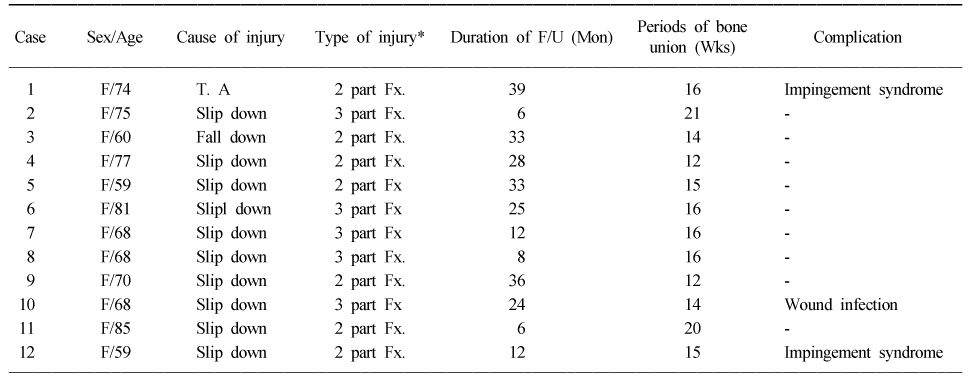

 Cite
Cite

